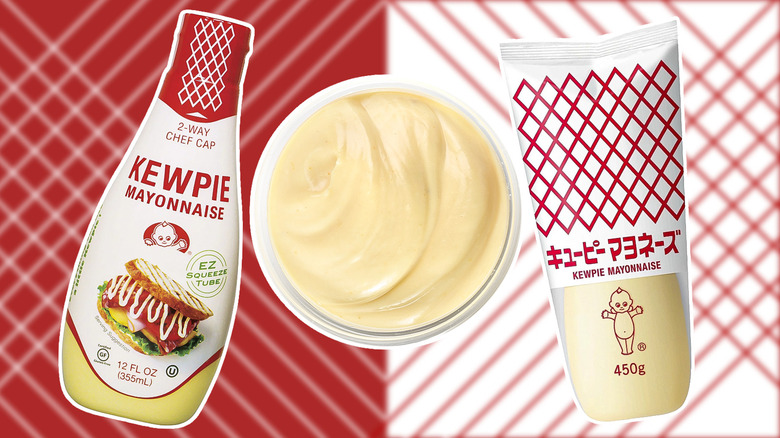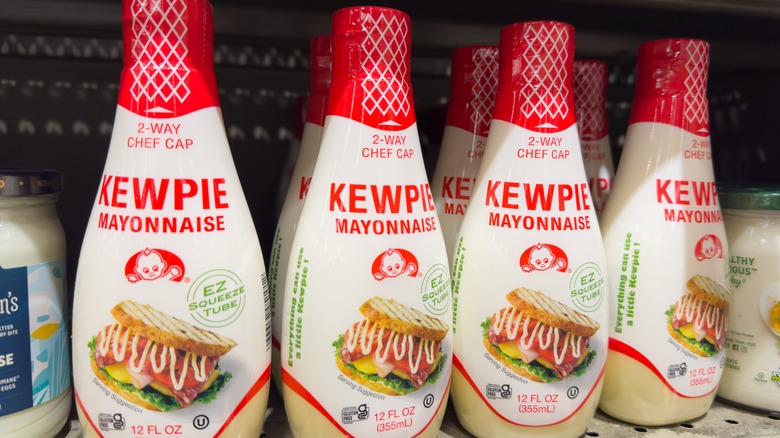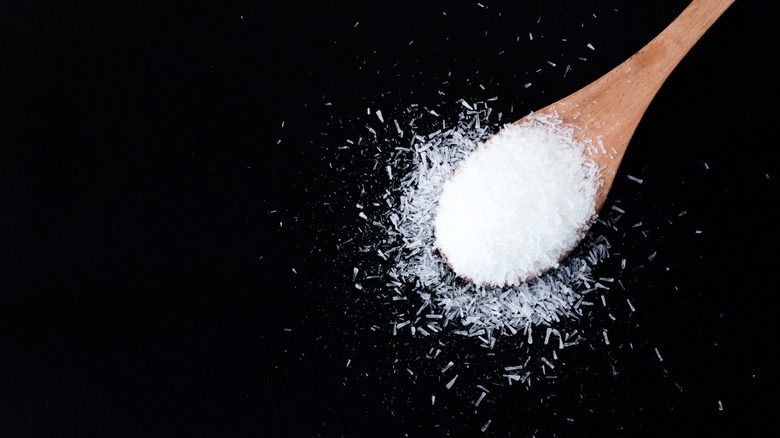How American Kewpie Mayo Differs From The Original
If you're tuned in to the world of food influencers, it won't be long before you hear somebody talking about Kewpie mayo. This Japanese condiment enjoys a level of popularity that verges on cultish, and with good reason. Many pro chefs consider Kewpie the best mayonnaise, thanks to its combination of flavor and texture. It is creamier than most other mayo brands and much richer. This is partly due to the fact that Kewpie is made with only egg yolks, while most other brands use whole eggs. You can see this fact reflected in Kewpie's light yellow hue. The other key to its flavor is monosodium glutamate, aka MSG, which brings a punch of umami flavor that no other mayonnaise offers.
Kewpie's history in Japan stretches back almost a century, but the condiment didn't appear at major American grocery chains until 2018. This has grown Kewpie's popularity in the States over the past few years, but the product most Americans are getting isn't the same one sold in Japan. The American version comes in smaller packages with a modified logo and without the iconic plastic sleeve that holds the Japanese version. That's nothing, however, compared to the change in ingredients, as American Kewpie omits MSG. This move has stirred controversy in the culinary world, with disagreements on how different the two products really are. More importantly, the choice to eliminate MSG points to a pervasive food myth that Americans just can't seem to move on from.
American Kewpie doesn't have MSG (but it kind of does)
In a nutshell, MSG is to umami what salt is to saltiness and sugar is to sweetness. It is the purest form of umami, and like salt and sugar, it looks like fine white crystals. Although its taste is hard to perceive on its own, when added to foods, MSG creates a deep, savory flavor that enriches practically any ingredients it touches. It is one of the primary reasons that so many chefs regard Kewpie as the pinnacle of mayonnaise, so omitting it makes a huge difference in the product.
Why, then, would Kewpie change its recipe for a new audience? The fact is, many Americans explicitly avoid MSG due to a pervasive belief that it can make you ill. Putting MSG on a list of ingredients could potentially drive some customers away, so it's understandable that Kewpie would want to avoid this. That's why you'll only see MSG on the Japanese label. However, the difference isn't quite so black and white because Kewpie found a loophole.
Although the American version of Kewpie omits MSG, it does contain yeast extract. Yeast extract contains naturally occurring glutamate, which is the basis of MSG. This makes it an appropriate substitute for MSG, although yeast extract doesn't contain quite as much glutamate as the little white crystals. Yeast extract also has a distinct, funky flavor (it's what Marmite and Vegemite are made from), whereas pure MSG is neutral and serves to accentuate other flavors.
What do Americans have against MSG?
MSG is a common ingredient in many global cuisines, but it is particularly associated with East Asian cuisine, and not always favorably. In the United States, MSG has given rise to a longstanding myth about Chinese food, which says that the ingredient causes all kinds of unpleasant ailments from headaches to heart palpitations to tingling extremities. In truth, such occurrences are rare, and the negative perception of MSG has a lot more to do with racial biases than actual science. To this day, many Americans explicitly ask for no MSG when they eat Chinese or Japanese food. At the same time, MSG is present in chips, ketchup, Parmesan cheese, tomatoes, and countless other products that Americans eat every day.
The negative myths about MSG seem to come up almost exclusively when discussing Asian cuisines, and it's understandable that such a bias would concern the makers of Kewpie as they look to expand. However, reviews of Kewpie's American version criticize it as bland compared to the original. The American version does include one additional flavor element in the form of sugar, which is likely done to match big American brands like Hellman's. But the ultimate result is a Kewpie mayo that exists somewhere between its original form and its American competitors. It's a step beyond other mayo brands, but not quite enough to match the legendary Japanese 7-Eleven egg salad.


